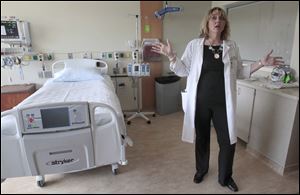
Toledo Hospital opens $10M stroke center
5/9/2012
Kelly Joseph, a registered nurse and stroke care coordinator at Toledo Hospital, shows off a patient room. Its 'telemedicine' technology allows doctors to examine and treat patients quickly.
ProMedica Toledo Hospital unveiled its $10 million stroke unit Tuesday to coincide with Stroke Awareness Month.
The 28,000-square-foot center is on the 10th floor of the hospital's Renaissance Tower and has 35 private rooms, including 15 for the neuro intensive care unit, all with private bathrooms.
The project also includes a therapy gym, electronic charting, a family waiting room with a computer, and a portable CT scanner. Each room is equipped with a mechanical lift for moving patients.
Signs of a stroke
Use FAST to remember the signs of a stroke.
F = Face. Ask the person to smile. If one side of the face appears crooked or drooping, the person may be having a stroke.
A = Arms. Ask the person to lift one or both arms. If this is difficult, it is a sign of a possible stroke.
S = Speech. Ask the person to speak. Slurring of words or inability to speak is a sign of a stroke.
T = Time. If any of the above symptoms are present, call 911 immediately because quick reaction is important in decreasing stroke damage.
Source: National Stroke Association
"It's going to improve our ability to treat patients who have suffered a stroke, both acutely as well as starting the rehab process" said Dr. James Sander, a neurologist.
Nurses have the ability to monitor rooms from their stations. An in-room camera and monitor bring patients face to face with doctors from remote locations.
"The 'telemedicine' technology allows doctors to examine and treat patients right away, whether the doctor is at home or in one of our other hospitals," said Kelly Joseph, a registered nurse and stroke-care coordinator. "No one has to travel, and the patient gets treated right away."
In coming weeks, the stroke center will get tablet computers for neuro ICU patients to help them communicate.
The previous stroke center was in a different area of the hospital and was along just one hallway with rooms on both sides. The new center has five more beds, additional staff, and advanced technology.
"This is good for the patients who are ventilated or can't speak," Ms. Joseph said. "They'll be able to press a button to say, 'I'm hungry' or 'I'm thirsty.' "
Toledo Hospital is recognized by the Joint Commission for certification as a primary stroke center. The distinction goes to centers that demonstrate long-term achievement of better outcomes for stroke patients, according to the commission's Web site.
Stroke is the leading cause of long-term disability in adults and is the nation's third leading cause of death, according to the Centers for Disease Control and Prevention.
In April, Toledo Hospital had 89 stroke alerts, which warn doctors and nurses that a current patient or incoming patient suffering from "acute neurological changes" may need immediate treatment.
More important than the treatment is recognizing the signs of a stroke, Ms. Joseph said.
"If they get here fast enough, there are therapies we can use to mitigate the damage," she said. "But most people don't realize they're having a stroke because they're not in pain. They don't have any signs other than the physical changes.
"You have to know the signs and get to the [emergency room] as soon as possible. It's the difference between walking out of the hospital and rolling out."
Contact RoNeisha Mullen at: rmullen@theblade.com or 419-724-6133.